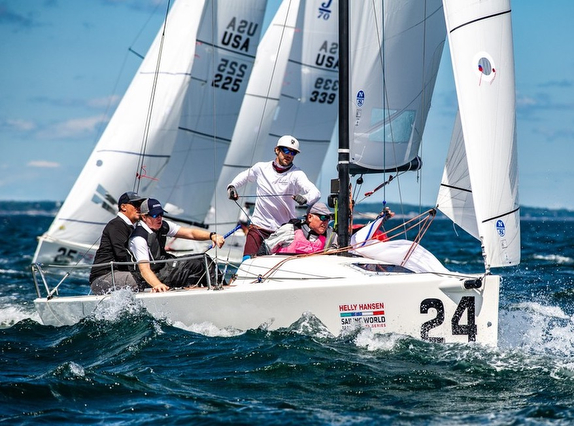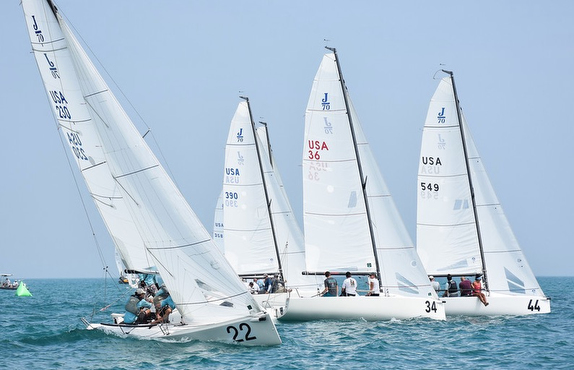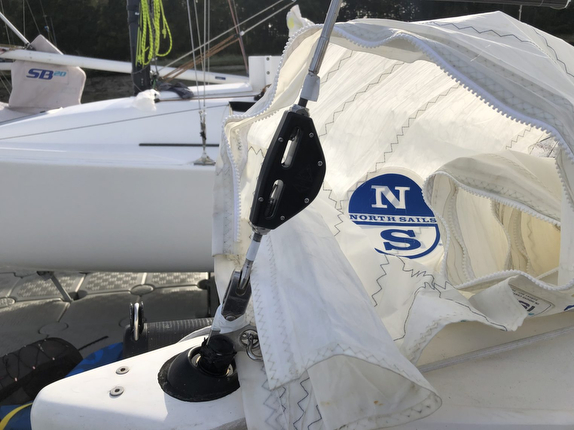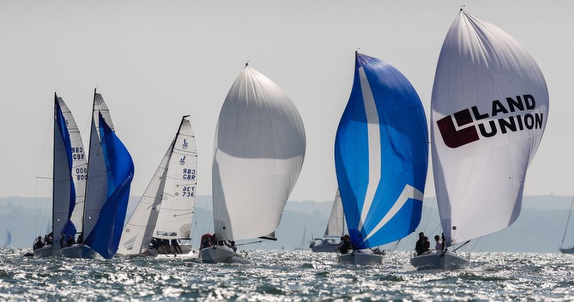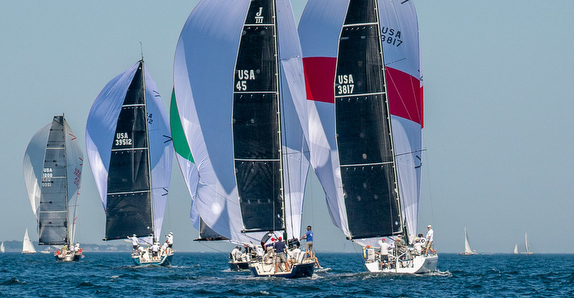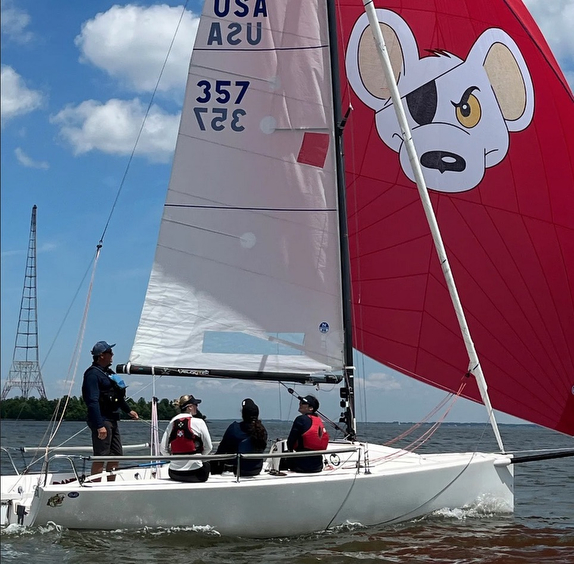(Annapolis, MD)- During a crash course in sailing a J/70 class sailboat on the Chesapeake Bay, one writer throws caution to the wind and rekindles her faith in new adventures. Here is Lauren Matison’s awesome article from CONDE NAST TRAVELER magazine…
“I’m in the sailing capital of America on a 22-foot J/70 called the “Danger Mouse” when I learn that helming a boat going 11 knots will blow you right out of your comfort zone.
“Everyone ready to jibe?”, I manage to squeak.
“Ready!” says the newbie crew, before moving across the boat. I stand up and do the tiller tango: glide sideways, duck under the boom, steer towards the next mark on the horizon, and don’t hit the deck. At one point, the sail catches a puff of wind, and some salty words like “Holy Helly Hansen!” fly out as I steady the tiller, which I surprisingly love operating.
As the J/70 surfs downwind, the bright red spinnaker sail with its fearsome cartoon mouse cuts a striking figure against the blue ombré sky. The estuary around us pulses with nautical enthusiasts: an older couple out for a day sail, a fleet of toy-sized 420s practicing race starts, sightseers on the Schooner Woodwind, a man and his dog in an inflatable dinghy. It’s just a regular Wednesday afternoon in Annapolis, Maryland.
I’m here to spend two days becoming a sailor in the Chesapeake Bay, where regattas have been held since 1910. I navigate around the maritime traffic and turn us towards the city’s outer green banks that beckon with big waterfront homes and slivers of sand. Kristen Berry of Gale Force Sailing talks about how to see gusts approaching and interpret wind by the fluttering telltale strings on the sails. We’re about to jibe again when a United States Naval Academy training boat appears on our port side, leaving waves and “Whoas!” in its wake.
I sense the hours are going by as I read the wind and alternate roles, completely dialed in and carefree like the osprey cruising alongside us. Mostly, I love holding that tiller and the empowering jolt that comes with it. I soon discover it’s also fun handling the main sheet, the line that controls the position of the sail; I can use it to get the boat to catch more wind and heel on its side, a wild off-kilter feeling.
In a fleeting moment, I realize that I haven’t thought about my usual anxieties—my daughter’s belly aches, climate change, the next freelance writing gig—since I left dry land. I learn that this is part of the whole experience: “There aren’t too many other activities that combine the physical and the cerebral the way that sailing does,” says Berry, who teaches first-year students at the Naval Academy in Annapolis, as well as underserved New York City kids through the Hudson Community Sailing school. “It’s something that you are fully present in; it’s hard to find that elsewhere these days.”
I begin to see sailing in a new light—as a transformative sport, a paean to adventure. I confide to my shipmates that I, ever the gung-ho helmsman, had barely made it on the trip. Earlier that morning, aboard the Amtrak train from New York to Annapolis, I was a nervous wreck, all bouncing knees and cracking knuckles. I was thinking about an incident years ago, on a sailboat in San Francisco, when I had a panic attack because a tangled line caused the boat to heel suddenly on its side. (If only I’d had lessons back then.) Suffice it to say, that close call left me terrified of capsizing and I hadn’t been on a sailboat since—not when we visited my in-laws in Florida and not when a local guide in Norway offered to take me on a sail around the Lofoten Islands.
But life works in mysterious ways. When my family moved from Brooklyn to a lake house in Connecticut 10 months ago, my six-year-old son couldn’t wait to explore the water, which happens to get the perfect amount of wind for learning to sail. With unpacked boxes still lining the hallway, I bought a beater Optimist dinghy on Craigslist for $200. Shortly after that, I booked a train ticket to Annapolis. I partially hoped to overcome the fears I might otherwise pass on to my two young kids; but also, as a burnt-out parent, I saw this experience as a great excuse for a solo kid-free escape—something I hadn’t had in four years.
In Annapolis, after long hours on the water, I wander around the city in my Helly Hansen jacket with that out-of-body bobbing sensation beginner sailors get back on land. I’m homesick for the sailboat, the adrenaline rush, the lapping of waves against the hull. I miss the ease of offline mode, gripping the tiller instead of my phone, concerned only with matters of the wind. I prefer the sailor version of me—free-spirited, clear-headed, energized by the pursuit of a new skill, however daunting—not the mercurial lapsed adventurer, drained from two years of raising kids and working through a pandemic without a real break.
I walk along the brick sidewalks and smile at fellow sunburnt sailors like we’ve been up to something together. A narrow lane next to the Iron Rooster, a popular brunch spot, leads to the colorful front doors on Pinkney Street and exquisite 18th-century buildings named Shiplap House and Hammond-Harwood House. Tucked away in Old Fox Books is Brown Mustache Coffee, where a Brooklynite-turned-Annapolitan barista makes a superb latte and talks up her new hometown. I tell her I wish I had more time to catch concerts at Rams Head Tavern and eat grilled scallops with fermented fish peppers at Preserve.Beer and snacks at Forward Brewing a new brewery in Eastport Maryland
At the Museum of Historic Annapolis, I learn that this city was the nation’s first peace-time capital in 1783 and that, in January 1784, up the road at the Maryland State House, the U.S. Congress ratified the Treaty of Paris, formally recognizing America’s sovereignty and ending the Revolutionary War. There are moving stories of prominent Black residents like John Maynard, whose home from 1847 still stands at 163 Duke of Gloucester St, and I want to linger over every exhibit covering the following 175 years of historical events— but I’m due back at the marina.
Passing the Annapolis City Dock, I spy the legendary 58-foot ocean racing yacht “Maiden” in a temporary slip; the first all-female crew to sail around the world did so on this boat, but nobody’s home for an autograph. I meet Berry and our two other crew members to watch Annapolis Yacht Club’s Wednesday night race from a motor boat. We zip up the bay to get close to the action, slowing at one point to see three generations of a family tacking beautifully on a J/105. Berry pushes the throttle and I am thoroughly drenched from the spray, but too enthralled by the race to care.
What I’ve missed isn’t being out on the water; it’s being out in the world on my own again, connecting with different people in a new place, testing my limits, and nurturing a deep restlessness that’s as vital as a rudder. These past two years, I’d forgotten how many solo adventures right my ship. After the last few long trips trekking through Patagonia and Peru, I returned home with relaxed shoulders and renewed resilience.
“Just imagine that the only things you have to help you sail are the natural things around you.”
That afternoon, when the boat heeled and I was pumping my fists in the air instead of panicking, I felt that familiar dramatic shift when you allow yourself to be vulnerable, admit to ignorance, and are open to change. Learning to sail in America’s sailing capital is to be under its spell; I am caught up in the dream of a life spent floating between sea and sky. As we zoom across the bay to observe spinnakers launching, I’m surprised that this is the first time I’m learning a new sport in the place where its culture is so celebrated.
I’m thinking I’ll need to change into some dry clothes when I’m told we’re going to be following sailors to their favorite watering holes, starting with “level four” painkillers at Pusser’s and Boatyard Bar lagers with beer-battered fish tacos. Somewhere around glass three, or maybe four, my ears begin ringing with Berry’s kernels of sailing wisdom from earlier that day: “Human nature wants us to keep pulling.” “Ease out, slow down.” “Once you’re empowered to know what you should be doing, then experiment.” “When often in doubt, rarely in error.” At the time, he was responding to questions about sailing. But hours later, it hits more like solid life advice.
On our last night, the “Danger Mouse” group takes a water taxi across the harbor to Eastport’s new nano-brewery, Forward Brewing, to drink Kölsch-style pints of Annapolis Boat Yard and plunge crostini into a smoked catfish spread. Down the block at Davis’ Pub, we settle into a picnic table with glasses of Sancerre and crab dip pretzels, looking like a bunch of sloshed and satisfied sailors.
Riding home on the train, I know that my next solo getaway won’t be long from now. I also know that on the lake this summer, the thing I’ll be passing on to my kids is a sailor’s high.” Thanks for this contribution from CONDE-NAST TRAVELER.

